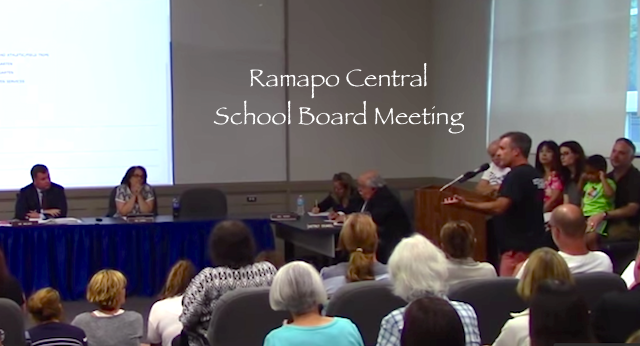
Ramapo Teachers Association President John Canty addresses the room at a recent Ramapo Central School District board meeting during a discussion of public transportation policy. / Photo via RamapoTA video.
For many years the Ramapo Central School District provided deluxe transportation services for non-public school students. In the name of fairness, efficiencies and tax dollar savings, the RCSD policy has been changed.
Beginning in the 2016-2017 school year, RCSD will shift to a one start time and one end time bus service for all children, no matter where they attend school, a policy the district believes will provide districtwide service while full-filling all New York state law requirements.
At a July 12 RCSD board meeting, hundreds crowded into the hallways and boardroom to show support for the district’s new policy. In years past, Ramapo Central had been providing non-public schools and private schools with transportation for multiple start times and end times, as well as providing non-public schools with transportation services even on days when public schools are closed.
The new policy ends that practice. And the packed room, mostly tax-paying residents with kids past and present in the school system, applauded the district policy.
Some did not. Several people from the surrounding orthodox community took to the microphone and politely suggested to the board and room that their extra transportation was a “benefit” and “right” they were “entitled” to because of their “needs.”
Bothi Roth, quoted in the Rockland County Times, said: “I, and I believe I speak for all members of the Jewish orthodox community when I say this, believe this is anti-Semitic.”
Some in the audience voiced in response that there’s a difference between community practices, entitlements, and policy decisions rooted in costs and efficiencies.
Ramapo Central has experienced an increase of 8% in transportation costs over the last budget year. Non-public school student transportation has increased partially due to the district’s practice of providing generous transportation services to private schools, and often accommodating different start and end times and special sessions and activities.
Many residents of the school district took to the microphone to share stories of their personal private school or special needs experiences, and repeatedly voiced that private education was a family choice that came with a personal responsibility by parents that included transport to and from school and activities. One parent said that there’s a difference between special needs and the expectation of an entitlement from the school district to address a family’s particular schedule and needs.
RCSD Board of Education meeting. It was standing room only. pic.twitter.com/CkyhSfpjaQ
— Ramapo TA (@RamapoTA) July 13, 2016
Ramapo Teachers Association President John Canty didn’t mince words on the subject of public school dollars being diverted to subsidize private and religious activities, especially in light of the on-going legal scrutiny of possible Ramapo and Rockland public corruption..
“We have always been and we will always be against public monies funding non-public activities,” Canty said about the RamapoTA position (to much applause). “Every dollar that goes to a non-public school, whether it’s a charter school or religious school, comes out of the public school classroom.”
Citing the recent landmark ruling of Lakewood, NJ, where an Appellate Division ruled against the state providing for private interests over public interests, Canty said that the RamapoTA will certainly consider its option of putting the “use of public school money for non-public activities regardless of religion … before the courts.”
Note: Section 3635 of the Education Law requires all non-city districts to provide transportation for pupils enrolled in kindergarten through grades 8 who live more than two miles from the school they attend and for pupils enrolled in grades 9-12 who live more than three miles from the school they attend up to a distance of fifteen miles.


